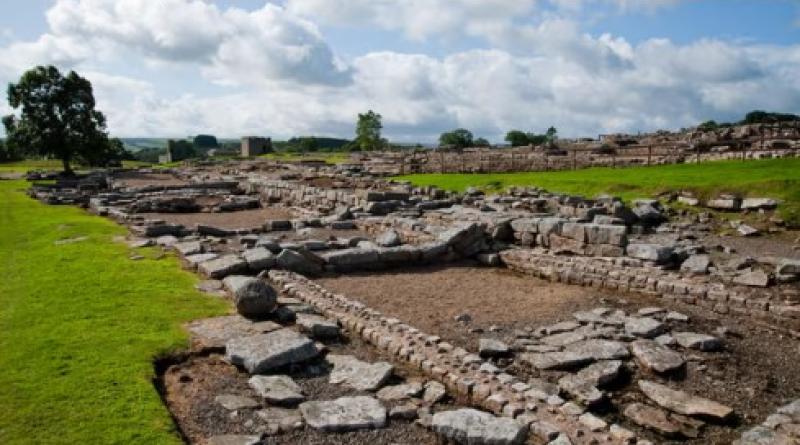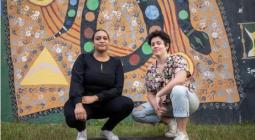The Roman forts near Hadrian’s Wall are full of historical riches – and the climate crisis is destroying them

Aremarkable discovery was made 50 years ago at Vindolanda, the Roman fort below Hadrian’s Wall. Four metres down, the archaeologist Robin Birley and his team came upon a mass of black, damp and stinky organic material. Miraculously preserved in this anaerobic time capsule were pieces of leather, including Roman shoes, some fragments of textile and numerous pieces of wood. These included a couple of thin, postcard-like, wooden leaf-tablets, less than 2mm thick, with strange marks on the surface that turned out to be cursive Latin written in ink.
The very first tablet discovered was a fragment of a letter, telling an unnamed soldier that socks and underpants had been dispatched, presumably in response to a plea for additional protection against the very damp and cold that would later preserve the note deep below ground. Now, the climate crisis is irreversibly altering these conditions, destroying Vindolanda’s buried treasures faster than archaeologists can get to them.
Vindolanda is a major Northumberland attraction, welcoming about 100,000 visitors a year – a must-see stop on the Hadrian’s Wall tourist trail. Over the decades, thousands of volunteers have taken part in excavations, most of them doing a couple of weeks digging, others returning time and time again. The discovery of the tablets, which made international headlines, is the main reason for its popularity.
Since that first discovery, more than 1,500 tablets – some complete, most just a few words or lines – have emerged from the deepest deposits. Most date to about AD100 and offer a remarkable insight into life in a Roman fort. Aside from that first scrap of text, two others stand out: the “strength report”, considered to be the most important document about the Roman army in Britain to have been discovered; and the “birthday invitation”, written by a fort commander’s wife, Claudia Severa, in about AD100, to Sulpicia Lepidina, the wife of the commanding officer at Vindolanda. Severa signs off: “Farewell my sister, my dearest and most longed-for soul.” This is thought to be the earliest evidence of female handwriting in Latin from anywhere in the Roman empire.
In the past 50 years, about 25% of the fort and settlement has been excavated. Another 150 years will be needed to excavate the rest, but much of the archaeology that makes Vindolanda so unique will be gone long before then. During the drought of 2022, it became clear that the site was drying out at an alarming rate. The damage being caused had already been indicated by the diminishing number of tablets being recovered: only a handful in recent seasons and about a dozen this year, whereas in those early days it was not uncommon to find hundreds in a single excavation season. Textiles have fared even worse. About 700 pieces have been recovered since digging began, but only a single piece in the past decade.
What is happening? Probes providing live data on conditions deep below ground have detected something troubling: oxygen in the previously anaerobic layers. Oxygen allows bacteria that break down organics to thrive. It is believed that extremes of weather characteristic of the changing climate are causing the problem. During dry periods the topsoil dries and cracks, allowing rainwater during wet periods to penetrate deeply, carrying oxygen and bacteria with it.
What can be done? Britain has enormous untapped archaeological secrets beneath its soil. There are about 27 forts in the Hadrian’s Wall region, of which only a few – including Vindolanda – have been excavated. It is true that most sites don’t have the unusual anaerobic conditions found at Vindolanda – on most, organics have long since rotted away. Nevertheless, there are 28,000 bog or marshland sites across Britain, many of which may preserve archaeological riches.
Until recently, archaeologists have been relaxed about leaving remains in the ground for future generations to explore. But Vindolanda, and the alarming effects of the climate crisis being witnessed there, turns this idea on its head. Robin Birley’s son, Andrew, who runs the Vindolanda Trust, has made the gloomy prediction that much of the organic material, including potentially hundreds more writing tablets, will be gone within 15 years. Digging Vindolanda has become an unwinnable race against time. What to save and what to let go?
Lepidina undoubtedly wrote a reply to the birthday invitation, a draft of which may still lie deep beneath the surface, probably near the commander’s house where she lived with her husband and children. The sad truth is that it probably has little chance of surviving. To the long list of destructions wreaked by the climate crisis, we now have to come to terms with the loss of our own shared heritage within the untold archaeological riches beneath our feet.
Richard Hobbs is the senior curator of the Romano-British and late Roman collections at the British Museum






